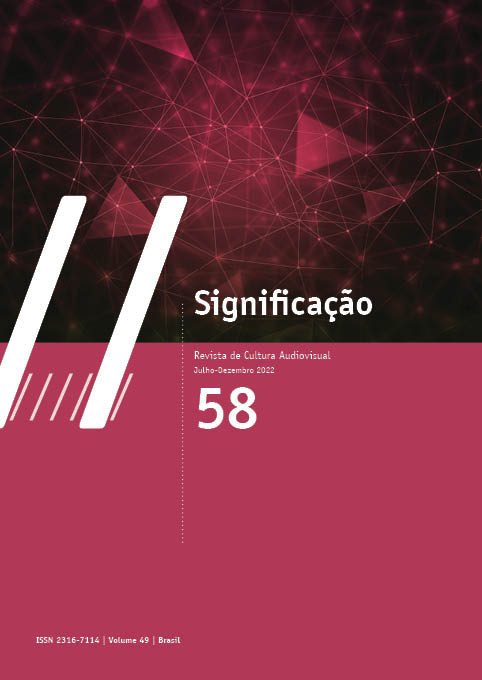The music of 2001: A Space Odyssey and the sublime object of cinema
DOI:
https://doi.org/10.11606/issn.2316-7114.sig.2022.192902Keywords:
Music, Soundtrack, Sublime, Spectator, PsychoanalysisAbstract
A notable stylistic element of 2001: A Space Odyssey (1968) is the innovative use of classical music, which, isolated from dialogue or sound effects, possesses an autonomous dimension of meaning. Borrowing Michel Chion’s concept of “anempathetic music”, we posit that two musical pieces—the Also sprach Zarathustra fanfare and the Blue Danube waltz—have very specific narrative and formal functions, to be analyzed here in terms of Lacan’s concepts of the imaginary and the symbolic, the gaze, suture, spectatorship, and the Kantian sublime. We aim to address and build on Annette Michelson’s formulation, in her seminal criticism, that 2001 is a film of cognitive restructuring and redefinition of cinema’s “shape of content”, through the role of music.
Downloads
References
BUKATMAN, S. “The artificial infinite: on special effects and the sublime”. In: KUHN, A. (org.). Alien Zone II: the spaces of science-fiction cinema. London: Verso, 1999. p. 249-274.
CHION, M. Kubrick’s cinema odyssey. London: BFI, 2001.
COPJEC, J. “The orthopsychic subject: film theory and the reception of Lacan”. In: COPJEC, J. Read my desire: Lacan against the historicists. Cambridge: MIT Press, 1994. p. 15-38.
KANT, I. Critique of the power of judgment. Cambridge: Cambridge University Press, 2009.
KOLKER, R. Cinema of loneliness. Oxford: Oxford University Press, 2001.
KUBRICK, S. “Interview with Joseph Gelmis”. In: PHILLIPS, G. (org.). Stanley Kubrick: interviews. Oxford: U. P. Mississippi, 2001. p. 80-104.
LACAN, J. Seminar XI: the four fundamental concepts of psycho-analysis. New York: Norton, 1998.
MICHELSON, A. “Bodies in space: film as carnal knowledge”. In: SCHWAM, S. (org.). The making of 2001: A Space Odyssey. New York: Modern Library, 2000. p. 194-215.
MULHALL, S. On Film. London: Routledge, 2001.
PIPPIN, R. Filmed thought: cinema as reflective form. Chicago: University of Chicago Press, 2020.
SONTAG, S. “Fascinating fascism”. In: NICHOLS, B. (org.). Movies and methods. Berkeley: UC Press, 1976. v. 1. p. 31-43.
TYGEL, D. A música no espírito do filme: música e narrativa no cinema. 2017. Dissertação (Mestrado em Música) – Centro de Letras e Artes, Universidade Federal do Rio de Janeiro, Rio de Janeiro, 2017.
WHITE, S. “Kubrick’s obscene shadows”. In: KOLKER, R. (org.). Stanley Kubrick’s 2001: A Space Odyssey: new essays. Oxford: Oxford University Press, 2006. p. 127-145.
ZIZEK, S. “The Hitchcockian blot”. In: ZIZEK, S. Looking awry: an introduction to Jacques Lacan through popular culture. Cambridge: MIT Press, 1992. p. 88-106.
ZIZEK, S. “The wound is healed only by the spear that smote you”. In: ZIZEK, S. Tarrying with the negative. Ithaca: Duke University Press, 1993. p. 165-199.
Downloads
Published
Issue
Section
License
Copyright (c) 2022 Pedro Groppo

This work is licensed under a Creative Commons Attribution-NonCommercial 4.0 International License.
Authors who publish in this journal must agree with the following terms:
- Authors keep their copyrights and grant the journal first time publication rights, having their articles simultaneously licensed under the Creative Commons Attribution License, which allows sharing texts with authorship recognition and first publication on this journal for non-commercial purposes.
- Authors are allowed to make additional contracts, for a non-exclusive distribution of the article’s version published on this journal (e.g.: publishing in institutional repositories of articles or as a book chapter), with authorship recognition and first publication on this journal.
















